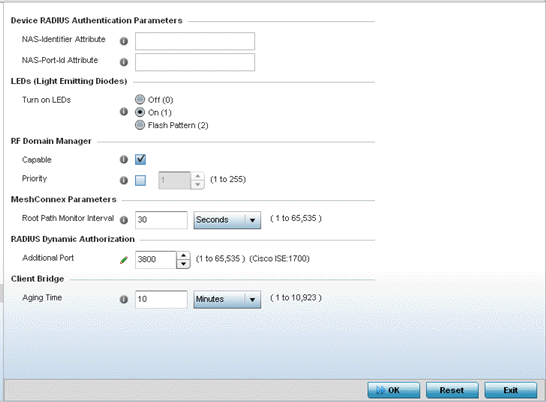Advanced Profile Miscellaneous Configuration
Refer to the advanced profile‘s Miscellaneous menu item to set the profile‘s NAS configuration. The profile database on the RADIUS server consists of user profiles for each connected network access server (NAS) port. Each profile is matched to a username representing a physical port. When users are authorized, it queries the user profile database using a username representative of the physical NAS port making the connection.
-
Select Miscellaneous from the Advanced Profile‘s menu item.

-
Set a NAS-Identifier Attribute up to 253 characters in length.
This is the RADIUS NAS-Identifier attribute that typically identifies the device where a RADIUS request originates.
-
Set a NAS-Port-Id Attribute up to 253 characters in length.
This is the RADIUS NAS port ID attribute which identifies the device port where a RADIUS message originates.
-
Select the Turn on LEDs option (within the LEDs (Light Emitting Diodes) field) to enable the LEDs on an access point.
Select the Flash Pattern(2) option (within the LEDs (Light Emitting Diodes) field) to flash an access point‘s LED‘s in a distinct manner (different from its operational LED behavior) to allow an administrator to validate an access point has received its configuration from its managing controller or service platform.
Enabling this feature allows an administrator to validate an access point has received its configuration (perhaps remotely at the site of deployment) without having to log into the managing controller or service platform. This feature is disabled by default.
-
Select the Capable option (within the RF Domain Manager section) to designate this specific profile managed device as being capable of being the RF Domain manager. The default value is enabled.
-
Select the Priority check box (within the RF Domain Manager section) to set a priority value for this specific profile managed device. Once enabled, use the spinner control to set a device priority between 1 - 255. The higher the number set, the higher the priority in the RF Domain manager election process.
-
Set the Meshpoint Behavior as either an External (Fixed) unit or a mobile Vehicle Mounted unit.
-
Configure a Root Path Monitor Interval, between 1 and 65,535 seconds, to specify how often to check if the meshpoint is up or down.
-
Set the Additional Port value for RADIUS Dynamic Authorization field. Set this value to 1700 to enable a CISCO Identity Services Engine (ISE) Authentication, Authorization and Accounting (AAA) server, when deployed in the network, to dynamically authenticate a client.
When a client requests access to the network, the CISCO ISE RADIUS server presents the client with a URL where the device‘s compliance to the networks security such as validity of anti-virus or anti-spyware software is checked for the validity for their definition files (this checking is called posture). If the client device complies, then it is allowed access to the network.
-
Set the Aging Time value for a dedicated Client Bridge. Use the spinner control to set a value in Days (1 -8), Hours (1 - 183), Minutes (1 - 10, 923) and Seconds (10 - 655, 350). The aging time represents the time this MAC address is allowed to remain on the network since its last update. The default setting is 10 minutes.
-
Select OK to save the changes made to the profile‘s Advanced Miscellaneous configuration. Select Reset to revert to the last saved configuration.



